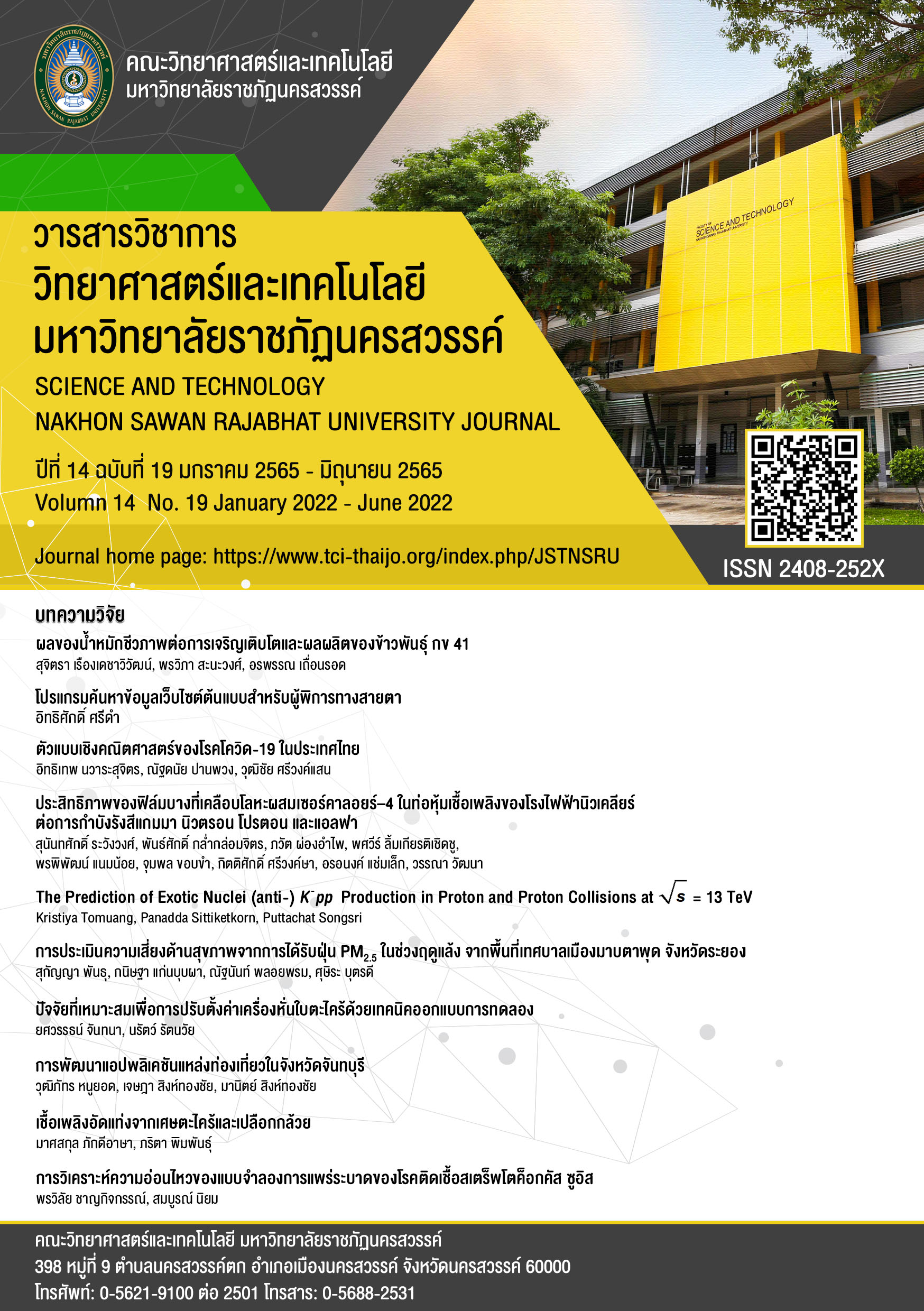ประสิทธิภาพของฟิล์มบางที่เคลือบโลหะผสมเซอร์คาลอยร์–4 ในท่อหุ้มเชื้อเพลิงของโรงไฟฟ้านิวเคลียร์ ต่อการกำบังรังสีแกมมา นิวตรอน โปรตอน และแอลฟา
Keywords:
ฟิล์มบาง , รังสีไอออไนซ์ , สัมประสิทธิ์การลดทอนเชิงมวล , Thin film, Ionizing radiation, Mass attenuation coefficientAbstract
งานวิจัยนี้ได้ศึกษาสมบัติการกำบังรังสีไอออไนซ์ชนิดที่ไม่มีประจุไฟฟ้าและมีประจุไฟฟ้าของโลหะผสมเซอร์คาลอยร์–4 (Zircaloy–4) หนา 500 นาโนเมตร ที่ถูกเคลือบด้วยฟิล์มบาง Al2O3, ZrO2, SiO2, TiO2, Fe2O3, NiO, Nb2O5 และ Y2O3 หนา 200 นาโนเมตร โดยค่าพารามิเตอร์สำหรับการกำบังรังสีไอออไนซ์ชนิดที่ไม่มีประจุไฟฟ้าได้แก่ ค่าสัมประสิทธิ์การลดทอนเชิงมวล เลขอะตอมยังผล และผลรวมภาคตัดขวางนิวตรอนพลังงานสูง ที่ช่วงพลังงานรังสีแกมมา 10–3–105 เมกะอิเล็กตรอนโวลต์ ในขณะที่การกำบังรังสีไอออไนซ์ชนิดที่มีประจุไฟฟ้าได้วิเคราะห์พารามิเตอร์ที่เกี่ยวกับความเสียหาย ได้แก่ ค่าไอออนกระเจิงกลับของอนุภาคแอลฟาและโปรตอนที่พลังงานจลน์ 10 กิโลอิเล็กตรอนโวลต์ ซึ่งผลการวิเคราะห์พารามิเตอร์ที่เกี่ยวกับคุณสมบัติในการกำบังรังสีไอออไนซ์ชนิดที่ไม่มีประจุไฟฟ้า ได้แก่ สัมประสิทธิ์การลดทอนเชิงมวล เลขอะตอมยังผล พบว่า ฟิล์มบาง Y2O3 มีค่าทั้งสองสูงที่สุดทำให้ทราบว่าฟิล์มบาง Y2O3 มีคุณสมบัติในการกำบังรังสีไอออไนซ์ชนิดที่ไม่มีประจุไฟฟ้าดีที่สุด ในขณะที่ฟิล์มบาง NiO มีคุณสมบัติการกำบังนิวตรอนพลังงานสูงดีที่สุด และฟิล์มบาง Al2O3 มีคุณสมบัติในการลดความเสียหายที่เกิดขึ้นจากรังสีไอออนชนิดที่มีประจุไฟฟ้าได้ดีที่สุด
References
Agar, O., Kavaz, E., Altunsoy, E. E., Kilicoglu, O., Tekin, H. O., Sayyed, M. I., Erguzel, T. T., & Tarhan, N. (2019). Er2O3 effects on photon and neutron shielding properties of TeO2-Li2O-ZnO-Nb2O5 glass system. Results in Physics, 13, 102277. https://doi:10.1016/j.rinp.2019.102277
Blau, P. J. (2014). A multi-stage wear model for grid-to-rod fretting of nuclear fuel rods. Wear, 313(1-2), 89-96. https://doi: org/10.1016/j.wear.2014.02.016
Brook, B. W., & Bradshaw, C. J. A. (2015). Key role for nuclear energy in global biodiversity conservation. Conservation biology, 29(3). 702-712. https://doi: 10.1111/cobi.12433
Cho, K. H., Kim, T. H., & Kim, S. S. (1998). Fretting wear characteristics of Zircaloy-4 tube. Wear, 219(1), 3-7. https://doi: 10.1016/S0043-1648(98)00164-1
Chou, T. C., Nieh, T. G., McAdams, S. D., & Pharr, G. M. (1991). Microstructures and mechanical properties of thin films of aluminium oxide. Scripta Metallurgica et Materialia, 25(10), 2203-2208. https://doi: 10.1016/0956-716X(91)90001-H
Dhal, S., Patro, A., Swain, M., Supraja, K., & Rath, P. K. (2020). Simulation of very-low energy alkali ion ( 10 KeV) induced effects on Al2O3 micro flakes. Indian Journal of Science and Technology, 13(21), 2111-2118. https://doi: 10.17485/IJST/v13i21.97
Dong, M. G., Sayyed, M. I., Lakshminarayana, G., Ersundu, M. Ç., Ersundu, A. E., Nayar, P., & Mahdi, M. A. (2017). Investigation of gamma radiation shielding properties of lithium zinc bismuth borate glasses using XCOM program and MCNP5 code. Journal of Non-Crystalline Solids, 468, 12-16. https://doi: 10.1016/j.jnoncrysol.2017.04.018
Edlou, S. M., Smajkiewicz, A., & Al-Jumaily, G. A. (1993). Optical properties and environmental stability of oxide coatings deposited by reactive sputtering. Applied optics, 32(28), 5601-5605. https://doi: 10.1364/AO.32.005601
Fiore, K. (2006). Nuclear energy and sustainability: Understanding ITER. Energy Policy, 34(17), 3334-3341. https://doi: 10.1016/j.enpol.2005.07.008
Fu, Y., Wei, J., & Batchelor, A. W. (2000). Some considerations on the mitigation of fretting damage by the application of surface-modification technologies. Journal of Materials Processing Technology, 99(1-2), 231-245. https://doi: 10.1016/S0924-0136(99)00429-X
Intom, S., Kalkornsurapranee, E., Johns, J., Kaewjaeng, S., Kothan, S., Hongtong, W., Chaiphaksa, W., & Kaewkhao, J. (2020). Mechanical and radiation shielding properties of flexible material based on natural rubber/ Bi2O3 composites. Radiation Physics and Chemistry, 172, 108772. https://doi: 10.1016/j.radphyschem.2020.108772
Issa, S. A. M., & Mostafa, A. M. A. (2017). Effect of Bi2O3 in borate-tellurite-silicate glass system for development of gamma-rays shielding materials. Journal of Alloys and Compounds, 695, 302-310. https://doi: 10.1016/j.jallcom.2016.10.207
Issa, S. A. M., Sayyed, M. I., Zaid, M. H. M., & Matori, K. A. (2017). A Comprehensive Study on Gamma Rays and Fast Neutron Sensing Properties of GAGOC and CMO Scintillators for Shielding Radiation Applications. Journal of Spectroscopy 2017, 1-9. https://doi:10.1155/2017/9792816
Kaur, P., Singh, D., & Singh, T. (2018). Gamma rays shielding and sensing application of some rare earth doped lead-alumino-phosphate glasses. Radiation Physics and Chemistry, 144, 336-343. https://doi: 10.1016/j.radphyschem.2017.09.018
Kim, K. T. (2009). The study on grid-to-rod fretting wear models for PWR fuel. Nuclear Engineering and Design, 239(12), 2820-2824. https://doi: 10.1016/j.nucengdes.2009.08.018
Kirdsiri, K., Kaewkhao, J., & Limsuwan, P. (2012). Photon interaction in borate glass doped with Bi2O3 at different energies. Procedia Engineering, 32, 727-733. https://doi:10.1016/j.proeng.2012.02.004
Limkitjaroenporn, P., Kaewkhao, J., Chewpraditkul, W., & Limsuwan, P. (2012). Mass attenuation coefficient and effective atomic number of Ag/Cu/Zn alloy at different photon energy by Compton scattering technique. Procedia Engineering, 32, 847-854. https://doi:10.1016/j.proeng.2012.02.022
Lin, Y., Cai, Z., Chen,Z., Qian, H., Tang, L., Xie, Y., & Zhu, M. (2016). Influence of diameter–thickness ratio on alloy Zr-4 tube under low-energy impact fretting wear. Materials Today Communications, 8, 79-90. https://doi:10.1016/j.mtcomm.2016.06.003
Morandin, G. D. & Sauvé, R. G. (2003). Probabilistic assessment of fretting wear in steam generator tubes under flow induced vibrations. American Society of Mechanical Engineers, Pressure Vessels and Piping Division, 465, 117-125. https://doi:10.1115/PVP2003-2081
Motta, A. T., Couet, A., & Comstock, R. J. (2015). Corrosion of zirconium alloys used for nuclear fuel cladding. Annual Review of Materials Research, 45, 311-343. https://doi:10.1146/annurev-matsci-070214-020951
Oto, B., Yıldız, N., Korkut, T., & Kavaz, E. (2015). Neutron shielding qualities and gamma ray buildup factors of concretes containing limonite ore. Nuclear Engineering and Design, 293, 166-175. https://doi:10.1016/j.nucengdes.2015.07.060
Qu, J., Cooley, K. M., Shaw, A. H., Lu, R. Y., & Blau, P. J. (2016). Assessment of wear coefficients of nuclear zirconium claddings without and with pre-oxidation. Wear 356-357, 17-22. https://doi: 10.1016/j.wear.2016.02.020
Rubiolo, P. R., & Young, M. Y. (2009). On the factors affecting the fretting-wear risk of PWR fuel assemblies. Nuclear Engineering and Design, 239, 68-79. https://doi:10.1016/j.nucengdes.2008.08.021
Sabol, G. P. (2005). “ZIRLOTM-An alloy development success,” 14th International Symposium on Zirconium in Nuclear Industry. ASTM STP 1467, 3-24. https://doi: 10.1520/STP37500S
Singh, V. P., Badiger, N. M., & El-Khayatt, A. M. (2014). Study on -ray exposure buildup factors and fast neutron-shielding properties of some building materials. Radiation Effects and Defects in Solids: Incorporating Plasma Science and Plasma Technology, 169(6), 547-559. https://doi: 10.1080/10420150.2014.905942
Tang, C., Stueber, M., Juergen, Seifert, M. J., & Steinbrueck, M. (2017), Protective coatings on zirconium-based alloys as accident-tolerant fuel (ATF) claddings. Corrosion Reviews, 35(3). 141-165. https://doi: 10.1515/corrrev-2017-0010
Ziegler, J. F. (2004). Srim-2003, Nuclear Instruments and Methods in Physics Research Section B: Beam Interactions with Materials and Atoms, 219-220, 1027-1036. https://doi:10.1016/j.nimb.2004.01.208
Ziegler, J. F., Ziegler, M. D., & Biersack, J. P. (2010). SRIM - The stopping and range of ions in matter (2010). Nuclear Instruments and Methods in Physics Research Section B: Beam Interactions with Materials and Atoms 268(11-12). 1818-1823. https://doi:10.1016/j.nimb.2010.02.091
Downloads
Published
Issue
Section
License
Copyright (c) 2022 SCIENCE AND TECHNOLOGY NAKHON SAWAN RAJABHAT UNIVERSITY JOURNAL

This work is licensed under a Creative Commons Attribution-NonCommercial-NoDerivatives 4.0 International License.



